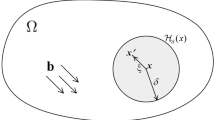Abstract
In this paper compute unified device architecture programming and open multiprocessing are used for the graphics processing unit and central processing unit parallel computation of material damage. The material damage is evaluated by a multilevel finite element analysis within material domains reconstructed from a high-resolution micro-focus X-ray computed tomography system. An effective computational method is investigated for solving the linear equations of finite element analysis. Numerical results show an encouraging trend in reducing the computation cost for the digital diagnosis of material damage.













Similar content being viewed by others
References
Hsu DK, Lee KS, Park JW, Woo YD, Im KH (2012) NDE inspection of terahertz waves in wind turbine composites. Int J Precis Eng Manuf 13(7):1183–1189
de Oliveira JM, de Lima FZC, de Milito JA, Martins ACG (2005) Development and applications of three-dimensional gamma ray tomography system using ray casting volume rendering. Braz J Phys 35(3B):789–792
Beckmann F (2008) Neutron and synchrotron-radiation-based imaging for applications in material science. In: Reimers W, Pyzalla AR, Schreyer A, Clemens H (ed) Neutrons and synchrotron radiation in engineering materials science. Wiley-VCH, New York, pp 287–307
Kubis AJ, Shiflet GJ, Dunn DN, Hull R (2004) Focused ion-beam tomography. Metall Mater Trans A 35(7):1935–1943
Bernard D, Gendron D, Heintz J, Bordere S, Etourneau J (2005) First direct 3D visualization of microstructural evolutions during sintering through X-ray computed microtomography. Acta Mater 53(1):121–128
Dobrich KM, Rau C, Krill CE (2004) Quantitative characterization of the three-dimensional microstructure of polycrystalline Al-Sn using X-ray microtomography. Metall Mater Trans A 35(7):1953–1961
Elaqra H, Godin N, Peix G, Mili MR, Fantozzi G (2007) Damage evolution analysis in mortar, during compressive loading using acoustic emission and X-ray tomography: effects of the sand/cement ratio. Cem Concr Res 37(5):703–713
Bonifazi G, Massacci P, Serranti S (2008) Micro-tomography techniques applied to particulate solids based products characterization. Granul Matter 10(4):315–321
Gopalakrishnan K, Ceylan H, Inanc F (2007) Using X-ray computed tomography to study paving materials. Construction Materials 160[CM1]. In: Proceedings of the Institute of Civil Engineers, pp 15–23
Daigle M, Fratta D, Wang LB (2005) Ultrasonic and X-ray tomographic imaging of highly contrasting inclusions in concrete specimens. In: GeoFrontier 2005 Conference, 12 pages
Wang LB, Frost JD, Voyiadjis GZ, Harman TP (2003) Quantification of damage parameters using X-ray tomography images. Mech Mater 35(8):777–790
Wang LB, Park JY, Fu Y (2007) Representation of real particles for DEM simulation using X-ray tomography. Constr Build Mater 21(2):338–346
Burlion N, Bernard D, Chen D (2006) X-ray microtomography: application to microstructure analysis of a cementitious material during leaching process. Cem Concr Res 36(2):346–357
Kacsuk P, Fahringer T (2007) Distributed and parallel systems: from cluster to grid computing. Springer, Berlin
Sosinsky B (2011) Cloud computing bible. Wiley, New York
Kirk DB, Hwu W (2010) Programming massively parallel processors: a hands-on approach. Morgan Kaufmann, Burlington
Shen J, Mao J, Boileau J, Chow CL (2014) Material damage estimated via linking micro/macroscale defects to macroscopic mechanical properties. Int J Damage Mech 23(4):537–566
Shen J, Diego V, Yoon D (2011) Removal of surface artifacts of material volume data with defects. In: Murgante B, Gervasi O, Iglesias A, Taniar D, Apduhan BO (eds) Computational science and its applications-ICCSA. Springer, Berlin, pp 624–634
Sanders J, Kandrot E (2010) CUDA by examples: an introduction to general-purpose GPU programming, Addison-Wesley Professional
Acknowledgments
This work was in part supported by National Science Foundation CMMI-0721625, ECCS-1039563, IIP-1445355, and the University of Michigan-Dearborn Undergraduate Fellowship.
Author information
Authors and Affiliations
Corresponding author
Rights and permissions
About this article
Cite this article
Shen, J., Vela, D., Singh, A. et al. GPU/CPU parallel computation of material damage. Engineering with Computers 31, 647–660 (2015). https://doi.org/10.1007/s00366-014-0367-9
Received:
Accepted:
Published:
Issue Date:
DOI: https://doi.org/10.1007/s00366-014-0367-9




